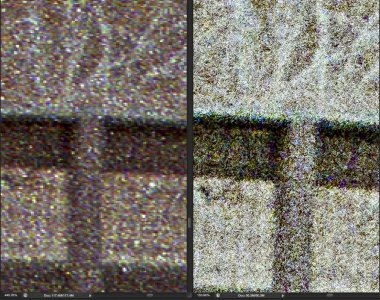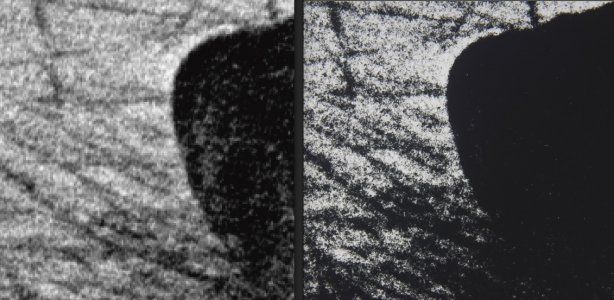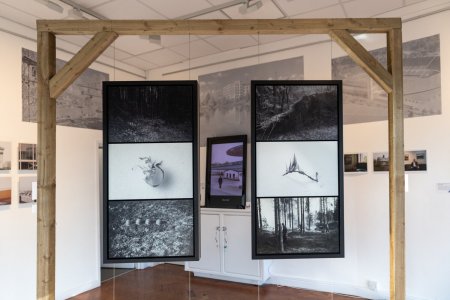PRJ
Another Day in Paradise
I find these film/digital things incredibly boring. Plus over the years the methodology of the results is always super suspect. In other words, film has to be brought into the digital space and that is where the comparison falls apart because people bringing film into the digital space don't actually do it right. The old idea that six megapixels is equivalent of a 35mm film frame is just a lie that was promoted by someone trying to make money off of digital sales. Kool-Aid anyone?
The reality is until recently film needed to be kept analogue for maximum quality. There are a lot of options these days. But I feel that good enough is good enough. No point in pursuing it really. In that vein I'll post a couple of comparisons I did years ago but never put online because I didn't want the vitriol that gets spewed at people pointing out the truth. Make of it what you will.
The first is a scan from Agfa Optima 100 in a Nikon 4000 scanner. The scan is at 4000 dpi which is a legitimate number (not like the inflated numbers of flat bed scanners like Epson). The second half of the image was taken from a camera scan at somewhere around 12,000 to 14,000 dpi if my memory serves. The difference should be obvious so I don't need to say anything more about it. Getting to this level of detail though is a PITA and fraught with problems and I don't know why anyone would do it frankly except in extraordinary circumstances. The neg was shot in a Leica with a Summicron 35mm.

The second example is also from a Nikon 4000 scanner. This time of a black and white neg. Fuji Neopan 400. Shot with a Konica Hexar but I don't remember the lens. Perhaps a Zeiss 35mm Biogon. The second half is from an enlargement done in the darkroom then scanned. IIRC I maxed out my Saunders enlarger and used my Zeiss Orthoplanar. The difference in the two should be apparent. 4000 dpi doesn't even come close to resolving the grain of even a 400 speed film. The enlargement though has plenty of room to spare.

I don't have a direct comparison between digital and film because frankly I'm not interested. My general feeling is when digital hit around 36 mp then they were about equal. At that point too they were still different so comparisons are difficult. Digital is great with edges but film is good with content/tonality. And of course as you increase the size of the neg film still wins out, though digital keeps getting better. And frankly, does it really matter anymore? These two example though should show the issue with comparisons at least on the film end. They were never fair. They were done by people who were either ignorant or who misled on purpose to line their pockets.
The reality is until recently film needed to be kept analogue for maximum quality. There are a lot of options these days. But I feel that good enough is good enough. No point in pursuing it really. In that vein I'll post a couple of comparisons I did years ago but never put online because I didn't want the vitriol that gets spewed at people pointing out the truth. Make of it what you will.
The first is a scan from Agfa Optima 100 in a Nikon 4000 scanner. The scan is at 4000 dpi which is a legitimate number (not like the inflated numbers of flat bed scanners like Epson). The second half of the image was taken from a camera scan at somewhere around 12,000 to 14,000 dpi if my memory serves. The difference should be obvious so I don't need to say anything more about it. Getting to this level of detail though is a PITA and fraught with problems and I don't know why anyone would do it frankly except in extraordinary circumstances. The neg was shot in a Leica with a Summicron 35mm.

The second example is also from a Nikon 4000 scanner. This time of a black and white neg. Fuji Neopan 400. Shot with a Konica Hexar but I don't remember the lens. Perhaps a Zeiss 35mm Biogon. The second half is from an enlargement done in the darkroom then scanned. IIRC I maxed out my Saunders enlarger and used my Zeiss Orthoplanar. The difference in the two should be apparent. 4000 dpi doesn't even come close to resolving the grain of even a 400 speed film. The enlargement though has plenty of room to spare.

I don't have a direct comparison between digital and film because frankly I'm not interested. My general feeling is when digital hit around 36 mp then they were about equal. At that point too they were still different so comparisons are difficult. Digital is great with edges but film is good with content/tonality. And of course as you increase the size of the neg film still wins out, though digital keeps getting better. And frankly, does it really matter anymore? These two example though should show the issue with comparisons at least on the film end. They were never fair. They were done by people who were either ignorant or who misled on purpose to line their pockets.
RichC
Well-known
OP here... I agree film vs digital is boring if there's no point.
However, I had a very good reason for finding the answer to the question, "How many megapixels is a high-quality film scan?" 10 years ago. Back then I used film and digital (a long-defunct 36 MP Nikon D800E), and make large exhibition-quality prints - so needed to know what film format would match my Nikon D800E in size and sharpness at A2 print size (16 x 23 in.).
Searching the web was useless: all kinds of answers, most of them clearly rubbish! I did physical tests using £20,000 Hasselblad X5 scanner, and also did a mathematical analysis based on real data (my first post in this thread).
My calculation backed up what my eyes saw: 645 medium-format film = 30-40 MP.
So, I knew I could exhibit large 645 and Nikon D800E prints together, and they wouldn't look visibly jarring.
I now use a Sony A7R IV with 60 MP. That's about equal to 6x9 medium-format film in sharpness.
I'm aware film and digital look different: I'm not looking to replace one with the other, nor interested in arguments about which is "better". I just want to know what film camera to use if I want to show large digital and film prints together. I have the answer now...
Large prints of mine...

MAP6 Collective - MAP6 Photography Collective
However, I had a very good reason for finding the answer to the question, "How many megapixels is a high-quality film scan?" 10 years ago. Back then I used film and digital (a long-defunct 36 MP Nikon D800E), and make large exhibition-quality prints - so needed to know what film format would match my Nikon D800E in size and sharpness at A2 print size (16 x 23 in.).
Searching the web was useless: all kinds of answers, most of them clearly rubbish! I did physical tests using £20,000 Hasselblad X5 scanner, and also did a mathematical analysis based on real data (my first post in this thread).
My calculation backed up what my eyes saw: 645 medium-format film = 30-40 MP.
So, I knew I could exhibit large 645 and Nikon D800E prints together, and they wouldn't look visibly jarring.
I now use a Sony A7R IV with 60 MP. That's about equal to 6x9 medium-format film in sharpness.
I'm aware film and digital look different: I'm not looking to replace one with the other, nor interested in arguments about which is "better". I just want to know what film camera to use if I want to show large digital and film prints together. I have the answer now...
Large prints of mine...

MAP6 Collective - MAP6 Photography Collective
CLAdictic
Established
Apples-oranges, film-digital. All I know is that I shoot film, digital only when left with no other alternative,i.e. film.
Godfrey
somewhat colored
So, no replies - presumably, then, you all agree with me!
I neither agree nor disagree with your calculations. My experience:
Years ago now, about 2003, I made a photograph of a lighthouse on the coast with a Canon 10D. That's a 5 or 6 Mpixel ancient sensor. When I was rendering the raw file, I saw what looked like a tiny fluff of white dirt ... like a piece of tissue paper being blown about in the wind. I was going to spot it out, but chanced to hit the zoom button which brought it up to 200% on screen. And I stopped and stared because what that little blob-mote turned out to be was a seagull soaring close to the wave tops.
No film image I've ever made could return enough detail to make that identification. That's when I came to the conclusion that, whatever the ultimate resolution of the digital camera might be, it was certainly adequate for any use I was going to put a camera to. My current cameras now have 40 and 50 Mpixel resolution and I can see things with them that I've never seen with any even medium format film.
Now back to pictures...
G
... oh yes: I use both digital and film cameras, depending on what I want to do in a given shooting session ...
Pál_K
Cameras. I has it.
My experience surprised me.
As a dedicated film shooter from Minox 8x11mm to 4x5” and instant films, I love the how film images look; I like using film. My most advanced digital cameras would be considered obsolete by today’s standards: a D700 or X-Pro1, take your pick.
Since I often make photos of cityscapes or landscapes, sometimes I’ll make photos from the same spot years apart and look for differences. I’ll photograph a distant hill three or four miles away and look at how the tree line changed or look at new houses that have been built on it.
I made one such photo with my F3/T, 50/1.4, and Kodak Gold 200 color film; I know I selected f/5.6 and I’m sure the shutter speed was about 1/500. I shot it handheld, but I’m a steady shooter. Looking at the negatives later, they were satisfyingly sharp. A distant house, garage, and barn maybe a mile away had enough detail for me to identify windows and other small details when I looked at the negative under magnification.
About a week later I was going through the same area with my X-Pro1 and I decided to make the same photo from the same spot using similar settings (using the XF 35/1.4 lens). This is a 16MP APS-C camera and I was expecting the distant dwellings in the resulting image to be digital mush. What I saw was spectacular: upon zooming in I saw more detail than I’d ever seen before.
Altbough this was hardly a carefully executed scientific comparison (both images were made handheld), the comparison of the two images gave me a new respect for the capabilities of even a modest digital sensor size.
I suppose I could find some old Kodak Technical Pan film and Technodol, or Adox CMS, and compare microfilm-like quality with digital (I do have a nice 16x20” Tech Pan image with detail and a tonal range that is stunning), but I really don’t care that much. “At the end of the day” (as Americans say), I still like using film and still like the images they produce.
As a dedicated film shooter from Minox 8x11mm to 4x5” and instant films, I love the how film images look; I like using film. My most advanced digital cameras would be considered obsolete by today’s standards: a D700 or X-Pro1, take your pick.
Since I often make photos of cityscapes or landscapes, sometimes I’ll make photos from the same spot years apart and look for differences. I’ll photograph a distant hill three or four miles away and look at how the tree line changed or look at new houses that have been built on it.
I made one such photo with my F3/T, 50/1.4, and Kodak Gold 200 color film; I know I selected f/5.6 and I’m sure the shutter speed was about 1/500. I shot it handheld, but I’m a steady shooter. Looking at the negatives later, they were satisfyingly sharp. A distant house, garage, and barn maybe a mile away had enough detail for me to identify windows and other small details when I looked at the negative under magnification.
About a week later I was going through the same area with my X-Pro1 and I decided to make the same photo from the same spot using similar settings (using the XF 35/1.4 lens). This is a 16MP APS-C camera and I was expecting the distant dwellings in the resulting image to be digital mush. What I saw was spectacular: upon zooming in I saw more detail than I’d ever seen before.
Altbough this was hardly a carefully executed scientific comparison (both images were made handheld), the comparison of the two images gave me a new respect for the capabilities of even a modest digital sensor size.
I suppose I could find some old Kodak Technical Pan film and Technodol, or Adox CMS, and compare microfilm-like quality with digital (I do have a nice 16x20” Tech Pan image with detail and a tonal range that is stunning), but I really don’t care that much. “At the end of the day” (as Americans say), I still like using film and still like the images they produce.
D
Deleted member 82967
Guest
- It comes easier, if you are accustomed to seeing high quality film prints. BTW for what Moriyama does, it does not matter if he shoots film or digital, because he likes graphic images - his film and digital images suck all the same in the sense, that they exhibit compressed range of tones. I am not saying, this is wrong, but this is not classic B&W photography the same way as paper cutouts or collages stuck on canvas are not the same as a Rembrandt painting.
May I ask what range of tones is considered "classic" in B&W photography and if there are any references that define that range?
[edit] oops, responded to an old post so ... anybody?
Whitten
Established
I'm a musician and the analog vs digital debate raged for years. Digital was/is more clinical, more detailed.
I think most musicians realised they didn't want more clinical detail. So over the last 20 years the makers of digital music gear have developed a lot of add-ons that increase saturation, a sort of audio blur, audio artefacts and 'faults'.
With film, I find it less sharp in practice.
Apart from the fun factor, which I think is huge for most people, the positive film brings to the table is a baked in look.
I recently scanned hundreds of images I shot with a Leica M6 on Trial-X 400. I was shocked how soft most of the images were and how much grain there was, often masking the detail. Of course all of that contributed to the film 'look'. Instant character.
A couple of years ago I bought a Bronica SQ, medium format camera and shot using decent quality film 100-200 ASA. Even scanning the negatives professionally it wasn't as clear and sharp as I remembered medium format being.
My eye has been conditioned by years of looking at digital images. Analog images look soft and grainy to me now. So it depends what you want in your images. Both approaches are valid.
I think most musicians realised they didn't want more clinical detail. So over the last 20 years the makers of digital music gear have developed a lot of add-ons that increase saturation, a sort of audio blur, audio artefacts and 'faults'.
With film, I find it less sharp in practice.
Apart from the fun factor, which I think is huge for most people, the positive film brings to the table is a baked in look.
I recently scanned hundreds of images I shot with a Leica M6 on Trial-X 400. I was shocked how soft most of the images were and how much grain there was, often masking the detail. Of course all of that contributed to the film 'look'. Instant character.
A couple of years ago I bought a Bronica SQ, medium format camera and shot using decent quality film 100-200 ASA. Even scanning the negatives professionally it wasn't as clear and sharp as I remembered medium format being.
My eye has been conditioned by years of looking at digital images. Analog images look soft and grainy to me now. So it depends what you want in your images. Both approaches are valid.
Share:

